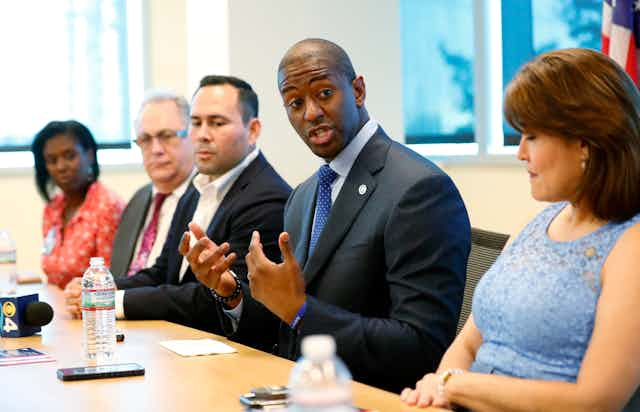Health care has been a universal topic of discussion this political season. Candidates from both parties say they are in favor of it, although definitions of “it” vary widely. But what all agree is that it has to do with access. Can I get the care I need when it is needed, or are there barriers such as pre-existing conditions? These are questions that vex patients and insurers including me in my former role as CEO of a health plan.
Politicians have been talking mostly about pre-existing conditions as the way to ensure access to health care. But as a former health care insurance company CEO who now studies health care finance, I see this view as too simple. There are multiple levels of access relevant here – availability of insurance, affordable premiums, limited cost-sharing, sufficient number of providers and freedom of choice.
Is access just having any insurance policy?
Republicans generally define access in terms of insurance coverage, at low premiums. And this election cycle, many of them have professed their support for coverage of pre-existing conditions. But they haven’t said how insurers would do this. However, many believe that the full coverage plans required by the Affordable Care Act overshoot the mark, as they drive premiums up.
Stripped-down plans recently allowed by the Trump administration, under their definition, provide sufficient access and will cost less since they cover less. Unfortunately, someone with a prior history of cancer will be able to purchase one of these, but the actual treatment for a recurrence may well be excluded to make the plans financially viable. Although we have not seen much detail, it is clear that they will offer significantly lower coverage leaving consumers on the hook for many expensive treatments.
Those other than invulnerable millennials would not consider this sufficient access. Even worse, many purchasers of these stripped-down plans may not understand this until it is too late (even though disclosure is required in large print).
To the extent that these low-priced policies attract a healthier population, they also will indirectly drive up premiums for everyone else. People bet against the insurers when they can, choosing more coverage when they are likely to need it and less when they think they will be healthy. This natural incentive, while largely based on self-delusion, leads to policies that financially penalize those who need coverage the most. This was the impetus behind the ACA individual mandate that everyone must buy a policy that meets minimum coverage requirements. Having healthy people in the pool spreads around the costs of covering sick people – including those with pre-existing conditions.
Of course, conservatives have sought to eliminate the mandate and pushed policies that give as many options as possible to consumer. But this fracturing of the insurance market is exactly what created the original dysfunctional situation limiting access to many people with the most need. A narrow definition of “access,” coupled with ideological commitment to completely unfettered markets, even if they fail many potential customers, leads to this dilemma.
But can I afford the cost even with insurance?
The next layers of access are also fraught with problems. One way employers and the government have dealt with higher health care costs is to drive up the amount the insured must bear through high-deductible policies. Such “cost-sharing” effectively forces individuals and families to become underfunded insurance companies. Picking up the initial costs assumes they will engage in healthy lifestyle choices and be more careful in seeking care. In reality, lower-income people tend to postpone needed care or become a bad debt to providers when they can’t pay.
In reaction to this access problem to reduce otherwise prohibitive financial obligations, the ACA forced insurers to offer plans that subsidized cost-sharing on a sliding scale based on the insured’s income. This worked well until the rules were changed.
Now insurers are still required to offer these reductions, but the government reneged on their promise to help finance them. As a result, insurers increased premiums dramatically. This preserved access to the working poor who qualify but decreased access to middle- and higher-income people who now have much higher premiums. It was a trade-off determined by political objectives, not any rational policy or economic reasoning.
But can I keep my doctor or hospital?

As part of this jerry-rigged system, insurers and employers have moved to narrow networks that limit the providers patients can access. This allows payers to both bargain for lower payment and, to a lesser extent, assure high-quality patient care.
As a result, now it is increasingly rare to have completely open access to all providers as employers and plans shrink the number of providers under contract. If one changes health plans or the network excludes a hospital, physician or other provider, a patient must go elsewhere or pay a ridiculous price.
The resulting out-of-network care is a troublesome area of ignorance for individuals and abuse by greedy providers seeking much higher rates than otherwise possible.
So what comes next?

The outcome of the elections is unlikely to change much in the near term, unless Democrats are elected governor in states that failed to expand Medicaid. But even then, legislatures may not agree.
So, to the extent that the ability to obtain care from the best provider is limited in any way, many continue to see a serious access issue requiring a complete revision of the system – thus the popularity of “single-payer” or “Medicare for All.”
Unfortunately, the reasons these access issues exist are not trivial. They include the desire to moderate demand, allow choice, negotiate provider payment, encourage responsiveness, reward appropriate care, and favor preventive services. It may well be that our current system’s confusing nature and failure to provide sufficient access will drive wholesale change. However, within each solution lies the need to deal with these many dimensions of access.

